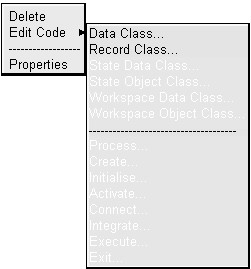Overview
The definition and creation of data objects is unlikely to depend on circuitry although it may depend on the particular way that the application's algorithms are parallelized. Once defined and created, data objects can be integrated with the circuitry. This section explains how data objects are associated with arbitrated and transient stores. See Entering Harness Code and Process Code for examples of accessing store records.
Adding Code
To specify a store record you must perform the following steps:
- Enter the name of the data type associated with the store (Transient or Arbitrated) in the Type attribute (category Record Reference) for the store object. When the circuit is translated, two files will be generated <Type>.hpp and <Type>Rec.hpp. Each file will contain the basic class definitions and default functionality. These files can be edited in steps 2 and 3 below.
- Edit the <Type>Rec.hpp file, by selecting Record Class from the Edit Code sub-menu for the store. This will open the file in the VS editor. For most data stores this step is not required (see Store Data Objects for details of variable sized data objects).
- Edit the <Type>.hpp file, by selecting Data Class from the Edit Code sub-menu for the store. This will open the file in the VS editor. This file is a standard C++ header file containing a stub for a <Type> data class. This class can be edited as a normal C++ class header. Users should add there own variables and access functions to this class. (see Data Components for details of variable sized data).

Examples
See Data Records
See Also
Reference
Data Records
Data Objects